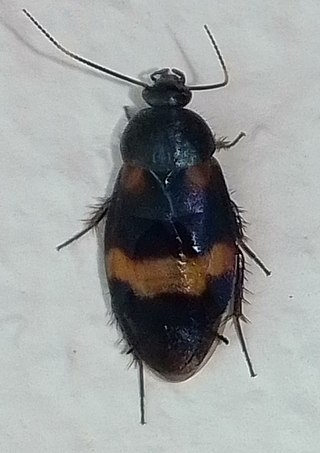
Giant cockroaches, or blaberids, are the second-largest cockroach family by number of species. Mostly distributed in warmer climates worldwide, this family is based on the American genus Blaberus, but much of the diversity is also found in Africa and Asia.

Blattidae is a cockroach family in the order Blattodea containing several of the most common household cockroaches. Notable species include:

Ectobiidae is a family of the order Blattodea (cockroaches). This family contains many of the smaller common household pest cockroaches, among others. They are sometimes called wood cockroaches. A few notable species include:

Corydiidae, previously known as Polyphagidae, is a family of the order Blattodea (cockroaches). Many are known as sand cockroaches. The family is divided into five subfamilies, comprising some 40 genera. One prominent species is the desert cockroach, Arenivaga investigata.

Holocompsa is a genus of hairy sand cockroaches in the family Corydiidae. It is the only genus in the subfamily Holocompsinae.

Periplaneta is a genus of cockroaches containing some of the well-known pest species with cosmopolitan distributions, such as:

Blaberus is a genus of cockroaches native to the Neotropics found in the Americas. At least 31 valid species are in the genus, as well as at least 39 invalid species, and some of them are popular among hobbyists as pets or as feed for other arthropods. Unlike several genera of cockroaches considered to be pests, this genus keeps its ootheca in its abdomen until the time it hatches. They generally require a relative humidity of 60% or higher to thrive and temperatures above 25 °C to reproduce.

Eublaberus is a genus of South American cockroaches in the subfamily Blaberinae, identified by Morgan Hebard in 1920.

The Pseudophyllodromiinae are a subfamily of cockroaches, in the family Ectobiidae, with a world-wide distribution.

Epilampra is a genus of cockroach in the family Blaberidae. There are more than 70 described species in the genus Epilampra.

Neoblattella is a genus of cockroach in the family Ectobiidae.

Cariblatta is a genus of cockroach in the family Ectobiidae. There are more than 70 described species in Cariblatta.

Chorisoneura is a genus of cockroach in the family Ectobiidae. There are at least 90 described species in Chorisoneura.

Ischnoptera is a genus of cockroach in the family Ectobiidae.

Pseudomops is a genus of cockroach in the family Ectobiidae. There are more than 40 described species in Pseudomops.

Latiblattella is a genus of cockroach in the family Ectobiidae.

Euthlastoblatta is a genus of cockroach in the family Ectobiidae. There are about nine described species in Euthlastoblatta.

Anaplecta is a genus in the family Anaplectidae. There are at least 20 described species in Anaplecta.

Paratropes is a genus of cockroaches within the family Ectobiidae. There are currently 14 species assigned to the genus. Members of this genus are distributed across North and South America in countries such as Mexico, Colombia, Panama and Peru.

Paranauphoeta is a genus of South East Asian cockroaches in the family Blaberidae and the monotypic subfamily ParanauphoetinaeRehn, 1951, erected by Carl Brunner von Wattenwyl in 1865. Species records are from India, China, Indochina, Malesia and New Guinea.





















